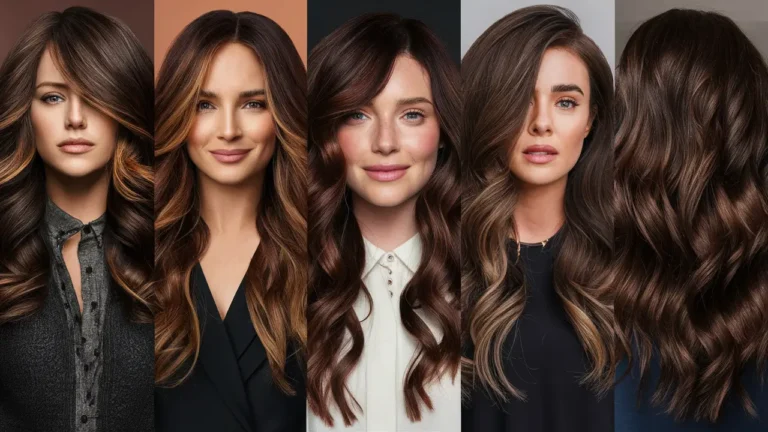The Science Behind Hair Breakage & How to Stop It
You’ve noticed more hair in your brush lately, and those frustrating short pieces around your hairline keep appearing.
Understanding the science behind hair breakage empowers you to take targeted action and restore your hair’s strength and resilience.
Understanding Your Hair’s Structure

The Three Layers That Determine Strength
Your hair consists of three distinct layers, each playing a crucial role in overall hair health.
The outermost layer, called the cuticle, acts like overlapping shingles on a roof, protecting the inner structures from environmental damage.
Beneath the cuticle lies the cortex, which makes up about 85% of your hair’s structure.
This layer contains the proteins and pigments that determine your hair’s strength, elasticity, and color.
The cortex houses long chains of keratin proteins held together by various chemical bonds.
The innermost layer, the medulla, appears only in thicker hair types and contributes to the hair’s overall structure.
When any of these layers becomes compromised, breakage becomes inevitable. Each layer requires specific care to maintain optimal health and prevent damage.
Understanding this architecture helps you recognize why certain treatments and habits either strengthen or weaken your hair.
The Role of Keratin Proteins
Keratin proteins form the backbone of your hair’s strength, creating a complex network of interlocking chains.
These proteins contain high levels of cysteine, an amino acid that forms disulfide bonds between protein chains.
These disulfide bonds act like bridges, holding the protein structure together and giving your hair its shape and strength.
When these bonds break down due to chemical processing, heat, or environmental factors, your hair loses structural integrity.
The keratin matrix also contains other proteins like cortex ins and microfibrils, which contribute to hair’s flexibility and resistance to breakage.
This protein network determines whether your hair can withstand daily styling and environmental stresses.
Protecting these protein structures becomes essential for preventing breakage.
Once the keratin matrix becomes severely damaged, complete repair becomes impossible, making prevention your best strategy.
Chemical Causes of Hair Breakage
How Hair Color and Processing Damage Structure
Chemical treatments alter your hair’s fundamental structure by breaking and reforming the protein bonds within the cortex.
Hair coloring, bleaching, and perming force open the cuticle layers to allow chemicals to penetrate deep into the hair shaft.
Bleaching agents like hydrogen peroxide break down melanin pigments but also attack the keratin proteins surrounding them.
This dual action weakens the hair’s structural integrity while achieving the desired color change.
Permanent hair color contains ammonia, which swells the hair shaft and allows dye molecules to penetrate.
While less damaging than bleaching, repeated coloring still compromises the cuticle and can lead to protein loss over time.
The alkaline nature of most chemical treatments raises the hair’s pH level, causing the cuticle scales to lift and remain partially open.
This leaves your hair vulnerable to further damage from environmental factors and daily styling.
The Cumulative Effect of Chemical Overlap
Your hair remembers every chemical treatment it has experienced, creating a cumulative effect that increases breakage risk over time.
Previously processed hair becomes more porous and absorbs new chemicals more readily, leading to over-processing.
The combination of multiple chemical services, such as coloring followed by perming or relaxing, creates a particularly high risk for severe breakage.
Each treatment weakens the hair’s defense mechanisms, making it less able to withstand subsequent processing.
Heat styling after chemical treatments compounds the damage by further dehydrating already compromised hair structures.
The combination of chemical and heat damage often proves too much for the hair’s protein matrix to withstand.
Understanding this cumulative effect helps you space treatments appropriately and choose less damaging alternatives when possible.
Your hair needs time to recover between chemical services to maintain its structural integrity.
Environmental and Physical Damage Factors

UV Radiation and Weather-Related Breakage
Ultraviolet radiation from sun exposure breaks down the protein structures in your hair much like it damages your skin.
UVA and UVB rays penetrate the hair shaft and cause photodegradation of keratin proteins.
Sun exposure also breaks down the natural oils that protect your hair, leaving it dry and brittle.
The cuticle becomes rough and raised, creating friction between hair strands that leads to tangling and breakage.
Wind and extreme weather conditions create additional mechanical stress on already weakened hair.
Dry, heated indoor air during winter months strips moisture from your hair, making it more susceptible to snapping.
Salt water and chlorine from swimming pools further compromise hair structure by stripping natural oils and altering the hair’s pH balance.
These environmental factors work together to weaken your hair’s defenses against breakage.
Mechanical Damage from Daily Habits
Your daily hair care routine may inadvertently cause more breakage than you realize. This seemingly minor friction adds up to significant weakening over months and years.
Aggressive brushing, especially when hair is wet and most vulnerable, can snap weakened hair strands.
Tight hairstyles that pull on the hair shaft create constant tension that eventually leads to breakage, particularly around the hairline.
Ponytails, braids, and up-dos can cause mechanical stress that accumulates over time.
Sleep friction against cotton pillowcases creates microscopic damage to the cuticle layer night after night.
Even the way you towel-dry your hair affects breakage rates. Rubbing wet hair vigorously with a terrycloth towel creates friction that lifts and damages the cuticle scales.
Heat Styling and Thermal Damage
How High Temperatures Affect Hair Proteins
Heat styling tools can reach temperatures exceeding 400°F, far beyond what your hair’s protein structure can safely withstand.
At these extreme temperatures, the water molecules within your hair shaft rapidly expand and can literally blow holes in the cuticle.
The keratin proteins begin to denature at temperatures around 300°F, causing irreversible changes to the hair’s structure.
This denaturation process is similar to cooking an egg – once the proteins change, they cannot return to their original form.
Repeated heat exposure gradually breaks down the disulfide bonds that hold your hair’s protein matrix together.
Each heat styling session removes a little more moisture and weakens the overall structure.
The speed at which you move styling tools also affects damage levels. Slow passes with high heat cause more damage than quick movements with moderate temperatures.
Protecting Hair During Heat Styling
Heat protectant products create a barrier between your hair and styling tools, but they cannot completely prevent damage at very high temperatures.
These products work by coating the hair shaft with silicones or proteins that absorb some of the heat energy.
Reducing your styling tool’s temperature, even by 50 degrees, significantly decreases damage while still achieving your desired style.
Most hair types can be effectively styled at temperatures between 250-350°F rather than maximum heat settings.
Using ionic or ceramic styling tools helps distribute heat more evenly and reduces hot spots that can cause severe localized damage.
These tools also seal the cuticle more effectively, reducing frizz and the need for multiple passes.
Limiting heat styling frequency gives your hair time to recover between sessions.
Even one or two heat-free days per week can significantly improve your hair’s overall health and reduce breakage rates.
Nutritional Factors in Hair Strength
Protein Requirements for Healthy Hair Growth
Your hair requires a steady supply of amino acids to build and maintain strong keratin structures.
Since hair growth occurs from the root, nutritional deficiencies affect new growth rather than existing hair length.
Inadequate protein intake forces your body to prioritize essential functions over hair growth, leading to weaker hair that breaks more easily.
Your hair follicles need specific amino acids like cysteine, methionine, and lysine to produce strong keratin.
Complete proteins from sources like eggs, fish, and lean meats provide all the essential amino acids your hair needs.
Plant-based proteins can also support hair health when consumed in varied combinations throughout the day.
The timing of protein consumption matters less than overall intake, but spreading protein throughout your meals helps maintain steady amino acid availability for hair synthesis.
Essential Vitamins and Minerals for Hair Health
Iron deficiency remains one of the most common nutritional causes of hair breakage and loss.
Iron helps carry oxygen to hair follicles, and deficiency can weaken the entire hair structure from the root.
Biotin, often called the “hair vitamin,” plays a crucial role in keratin production. Low vitamin D levels correlate with increased hair breakage and slower growth rates.
While biotin deficiency is rare, supplementation may help improve hair strength in individuals with marginal intake levels.
Vitamin D receptors in hair follicles suggest this vitamin’s importance for healthy hair growth. Zinc supports protein synthesis and cell division in hair follicles.
Severe zinc deficiency can cause hair to become brittle and break easily, though moderate deficiencies may also contribute to weakness.
Prevention Strategies That Actually Work

Gentle Handling Techniques
Treating your hair gently during washing and styling dramatically reduces breakage over time.
Use lukewarm water instead of hot water to prevent excessive cuticle swelling and protein loss.
Apply shampoo only to your scalp and let the suds cleanse your hair length as you rinse.
This prevents over-cleansing the more fragile ends of your hair that don’t accumulate as much oil and product buildup.
When detangling, start at the ends and work your way up to the roots using a wide-tooth comb or detangling brush.
This technique prevents the formation of knots that require forceful removal. If you must detangle wet hair, use a leave-in conditioner for slip and protection.
Never brush or comb wet hair aggressively, as wet hair stretches up to 30% more than dry hair and snaps more easily.
Smart Product Selection and Usage
Choose shampoos with gentle surfactants that clean effectively without stripping your hair’s natural protective oils.
Sulfate-free formulas often provide adequate cleansing with less potential for damage.
Deep conditioning treatments once or twice weekly help replenish moisture and temporarily fill in damaged areas of the cuticle.
Look for products containing proteins for strength and moisturizing ingredients for flexibility.
Leave-in treatments provide ongoing protection throughout the day, especially if you live in a harsh climate or style your hair frequently.
These products create a protective film that reduces friction and environmental damage.
Avoid products with high alcohol content, as they can dehydrate your hair and make it more prone to breakage.
Read ingredient lists and choose formulas with moisturizing alcohols like acetyl alcohol instead of drying alcohols like isopropyl alcohol.
Advanced Breakage Prevention Methods
Professional Treatments That Strengthen Hair
Salon protein treatments can temporarily strengthen damaged hair by filling in gaps in the cuticle and cortex with hydrolyzed proteins.
These treatments work best on moderately damaged hair that still retains some structural integrity.
Keratin treatments smooth the cuticle and add a protective coating, but they’re not permanent solutions for breakage prevention.
The effects typically last 3-4 months and gradually wear off with washing and styling.
Regular professional trims remove split ends before they travel up the hair shaft and cause more extensive breakage.
Even small trims every 6-8 weeks can prevent minor damage from becoming major problems.
Professional deep conditioning with steam or heat helps ingredients penetrate more effectively than at-home treatments.
These intensive sessions can provide temporary strength improvements for severely damaged hair.
Creating a Protective Hair Environment
Sleeping on silk or satin pillowcases reduces friction that leads to overnight breakage.
These smooth surfaces allow your hair to glide rather than catch and tangle during sleep movements.
Using a humidifier in dry environments helps maintain optimal moisture levels in both your hair and the surrounding air.
Proper humidity prevents your hair from becoming overly dry and brittle. Avoid tight elastics or metal accessories that can create pressure points and breakage.
Protective hairstyles for sleep, such as loose braids or silk scrunchies, prevent tangling and reduce friction damage.
Regular scalp massage improves blood circulation to hair follicles, potentially promoting stronger hair growth from the root.
While this doesn’t repair existing damage, it may improve the strength of new growth over time.
When to Seek Professional Help

Recognizing Severe Breakage Patterns
Sudden increases in hair breakage may indicate underlying health issues or product reactions that require professional evaluation.
If you notice breakage patterns that don’t improve with gentle care, consult a dermatologist or trichology’s.
Breakage accompanied by scalp irritation, unusual hair texture changes, or patchy areas of damage may signal allergic reactions or medical conditions affecting hair health.
Professional hair analysis can identify specific damage patterns and recommend targeted treatments based on your hair’s individual needs and damage history.
Don’t attempt to self-diagnose severe breakage issues, as improper treatment can worsen the condition and lead to permanent hair loss in some cases.
Conclusion
Understanding hair science empowers you to make informed decisions that protect your hair’s structure and prevent future breakage through targeted care strategies.







